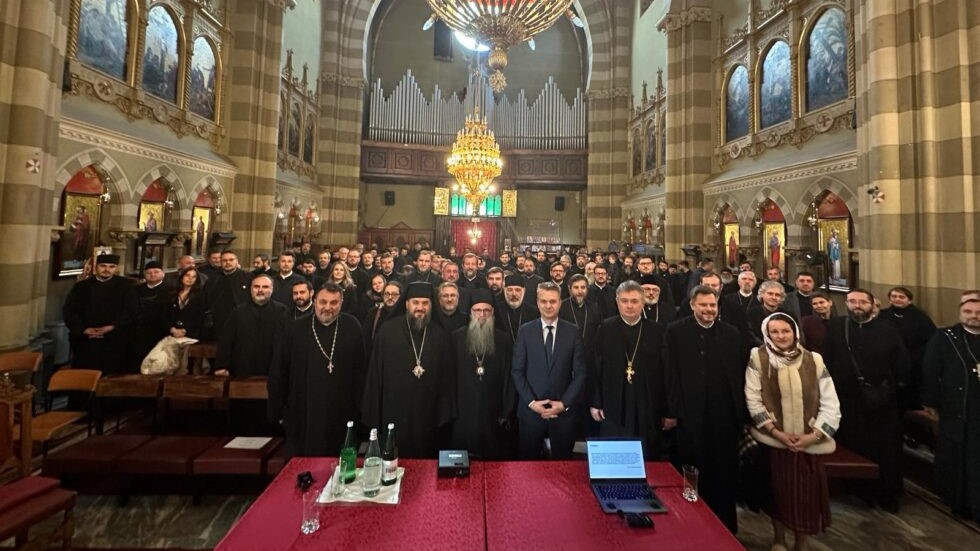Assistant Bishop Benedict of Bistrița wrote an essay exclusively for Basilica.ro inspired by the work of his spiritual patron Saint.
Please find below Bp Benedict’s essay:
Saint Benedict of Nursia, on self-realization
Along with Saints Basil the Great or John Cassian, Saint Benedict of Nursia is among the founders and organizers of monastic life. He writes a monastic Rule in the distant sixth century, which will enjoy an uninterrupted up-to-date interpretation and application from then to the present day, overcoming the test of time.
There is a terminology in vogue in the contemporary vocabulary of a psychological nature – self-esteem, self-confidence, self-image – contained in what is called self-realization.
And this last concept aims at man standing face to face with the highest standards, with targets and expectations accordingly.
By associating such an ancient text as Saint Benedict’s “Rule of a Monastic Way of Life” with these demands, a reader might be surprised to discover a set of practical ideas expressed simply and organized, but with immediate reference to everyday life.
In addition, they provide a safe, time-tested framework but also leave room for personal interpretation.
Attempting a systematic and up-to-date reading, I reckon we could speak of “a Benedictine method” of self-realization, generically described by the practice of humility, in paradoxical and essential terms.
This work provides for twelve steps or understandings, described synthetically in chapter VII of his Rule, in an obvious qualitative sequence.
Numerous hermeneutics throughout time have interpreted this scale, connected to time and space, from various perspectives. I will also try this in this short essay, making an overview intended, above all, for young people.
The beginning of the ladder is marked by the fear of God, whose icon is man, interpreted as a form of self-respect. This state reminds him of his identity in terms of excellence and, at the same time, puts him on guard and teaches him caution in the face of possible unfortunate falls. Fear has preventive value but also assurance.
The second step further indicates a challenging attitude for the contemporary youth – the diminution of the expression of personal will in favour of the good of those around or their own good, but later, in the future. Humility is highlighted here by accepting that one’s desire is not always the best or the most useful. It requires dialogue and negotiation with others and their opinions for a realistic and solid future architecture.
The third level of humility is expressed by the willingness to obey the one with authority. Accepting that there are people more competent and experienced than you is a sign of maturity but also of necessary prudence, protecting you from unpleasant experiences.
The fourth station involves patience and perseverance in the most challenging moments, with a fixed eye on the goal, against the tendency to run away from difficulties, and a frequent attitude in the mentality of the time.
The fifth form of humility is expressed by the need to admit your mistakes, at the level of thought and deed, before the one responsible for you and your life to not persevere in evil and improve your condition. We need a corrective – someone to tell us when we’re wrong and help us make things right.
Arriving halfway up the ladder, at the sixth station, we notice that humility is expressed under the face of serenity, as resistance and immovability amid uncomfortable situations, when we are treated inappropriately when we go through moments of spiritual poverty or a particular state of unfulfillment.
This experience increases in intensity with the seventh step assimilated to self-condemnation, which shifts the emphasis from one’s own powers to the work of God out of the desire to accomplish significant things synergistically. An inversely proportional mathematical exercise is revealed here – as self-confidence diminishes, so, consequently, does confidence in God and His work increase. This perspective reveals an increasingly visible personal freedom, accompanied by an increasingly intense love for God.
The eighth station indicates strict attention to the order undertaken and concentration on the task at hand. This moment calls for the consciousness of real presence and perfect superimposition over the mission at hand.
Humility is further manifested, on the ninth scale, through the call to silence, as a form of manifestation of prudence in the face of sin, but also as a means of cognitive enrichment, through the availability to receive new information and experiences from your neighbour.
The tenth step indicates benevolence as a reaction to a possible scattered and haphazard attitude to uncontrolled or disorderly behaviour. Kindness is expressed through balance and discernment.
The eleventh stop is accompanied by the ability to communicate elegantly, measuredly, and calmly, showing discretion and sensitivity.
The last step of the humility ladder, the twelfth, has a comprehensive and synthesizing character since it indicates its integral manifestation, externally, but also internally, at the level of the body, but also of the spirit, as a result of an entire process, indicating now a well-defined spiritual personality. This is the lesson that Saint Benedict of Nursia gives us.
This can be your way too. Get close to it, research it, and explore it! And then, put your foot on the first step and look up! Take note of the directions and accompany yourself with those who have travelled before you! And don’t turn back from the road! A beautiful journey awaits you, a spiritual adventure at the end of which the joy of fulfilment will greet you. All you have to do now is be brave!
† Benedict of Bistrița
Assistant Bishop to the Archdiocese of Vad, Feleac and Cluj
Photography source: Facebook / ASCOR Cluj-Napoca
Follow us on Twitter: @BasilicaNews






